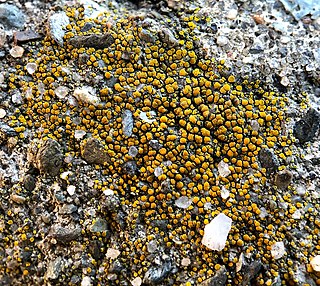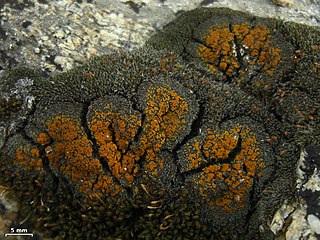
The Teloschistaceae are a large family of mostly lichen-forming fungi belonging to the class Lecanoromycetes in the division Ascomycota. The family has a cosmopolitan distribution, although members occur predominantly in subtropical and temperate regions. Most members are lichens that either live on rock or on bark, but about 40 species are lichenicolous – meaning they are non-lichenised fungi that live on other lichens. Many members of the Teloschistaceae are readily identifiable by their vibrant orange to yellow hue, a result of their frequent anthraquinone content. The presence of these anthraquinone pigments, which confer protection from ultraviolet light, enabled this group to expand from shaded forest habitats to harsher environmental conditions of sunny and arid ecosystems during the Late Cretaceous.

Gyalolechia is a genus of lichen-forming fungi belonging to the family Teloschistaceae. It contains 18 species of crustose lichens.

Flavoplaca is a genus of crust-like or scaly lichens in the family Teloschistaceae. It has 28 species with a mostly Northern Hemisphere distribution.

Xanthocarpia is a genus of mostly crustose lichens in the family Teloschistaceae. It has 12 species with a largely Northern Hemisphere distribution.

Wetmoreana is a genus of lichen-forming fungi in the family Teloschistaceae. It has two crustose, saxicolous (rock-dwelling) species.

Xanthocarpia feracissima is a species of saxicolous, crustose lichen in the family Teloschistaceae. It was first formally described as a new species in 1953 by Swedish lichenologist Adolf Hugo Magnusson, as a member of the genus Caloplaca. The type specimen was collected in 1939 by John Walter Thomson in Lake Koshkonong, Wisconsin. In the original description, Magnusson notes a similarity to the lichen now known as Gyalolechia flavovirescens, but distinguishes the new species by its lack of a visible thallus, the sordid-reddish color of its discs, and the "unusually narrow" septa of the spores. Patrik Frödén, Ulf Arup, and Ulrik Søchting transferred the taxon to Xanthocarpia in 2013, following molecular phylogenetic analysis of the family Teloschistaceae.
Austroplaca hookeri is a species of saxicolous (rock-dwelling), crustose lichen in the family Teloschistaceae. It was originally described by Carroll William Dodge in 1965, as Gasparrinia hookeri. The type specimen was originally collected by British botanist and explorer Joseph Dalton Hooker on Cockburn Island; the species is named in his honour. The taxon was transferred to the large genus Caloplaca in 2004, and again to the genus Austroplaca in 2013 as part of a restructuring of the family Teloschistaceae.
Solitaria is a fungal genus in the family Teloschistaceae. It contains a single species, the corticolous (bark-dwelling), crustose lichen Solitaria chrysophthalma.
Calogaya alaskensis is a species of crustose lichen in the family Teloschistaceae. It was first described as new to science in 2004 by Clifford Wetmore, who placed it in the genus Caloplaca. Ulf Arup and colleagues transferred the taxon to Calogaya in 2013 following a molecular phylogenetics-led restructuring of the Teloschistaceae.
Usnochroma is a genus of lichen-forming fungi in the family Teloschistaceae. It has two species of crustose lichens. The genus was circumscribed in 2013 by lichenologists Ulrik Søchting, Ulf Arup, and Patrik Frödén, with Usnochroma carphineum assigned as the type species. The genus name refers to the yellowish-green colour of the thallus, which is caused by the substance usnic acid. Usnochroma species occur in Macaronesia, South Africa, the Mediterranean Basin, and Algeria.

Leproplaca cirrochroa is a widespread and common species of saxicolous (rock-dwelling), crustose lichen in the family Teloschistaceae. It grows up to 5 cm across, featuring a placodioid thallus with narrow, finger-like lobes that adhere closely to the surface, showing intricate division and ranging in colour from dirty orange to brownish orange, often with paler, pruinose orange ends.
Xanthocarpia erichansenii is a species of terricolous (ground-dwelling), crustose lichen in the family Teloschistaceae. It is found in southwest Greenland, where it grows on loess among mosses.

Flavoplaca austrocitrina is a species of saxicolous (rock-dwelling), crustose lichen in the family Teloschistaceae. It is widely distributed in Europe, and has also been recorded in South America.

Flavoplaca limonia is a species of saxicolous (rock-dwelling), crustose lichen in the family Teloschistaceae. It was first formally described as a new species in 1994 by lichenologists Pier Luigi Nimis and Josef Poelt. Ulf Arup and colleagues transferred the taxon to the genus Flavoplaca in 2013, following a molecular phylogenetics-based restructuring of the family Teloschistaceae.

Flavoplaca maritima is a species of crustose lichen in the family Teloschistaceae. It is found in costal areas of Northern, Western, and Southern Europe. It mostly occurs on rocks, but has also been recorded growing on wood.

Parvoplaca tiroliensis is a species of crustose lichen in the family Teloschistaceae, and the type species of the genus Parvoplaca. It is widely distributed, and has been recorded growing on a variety of substrates, including moss, dead plant material, and bone.
Flavoplaca kantvilasii is a species of saxicolous (rock-dwelling), crustose lichen in the family Teloschistaceae. Found in Australia, it was formally described as a new species in 2007.
Flavoplaca arcisproxima is a species of saxicolous (rock-dwelling), crustose lichen in the family Teloschistaceae. It is found primarily in the coastal regions of the Crimean Peninsula and the eastern Mediterranean, particularly in Crete, Greece.

Flavoplaca oasis is a species of saxicolous (rock-dwelling), crustose lichen in the family Teloschistaceae. It is widely distributed across Europe, and has been reported in Western Asia, China, and North Africa.
Scutaria is a single-species fungal genus in the family Teloschistaceae. It contains the species Scutaria andina, found in South America. The thallus of this lichen has a form that is intermediate between crustose and foliose.












